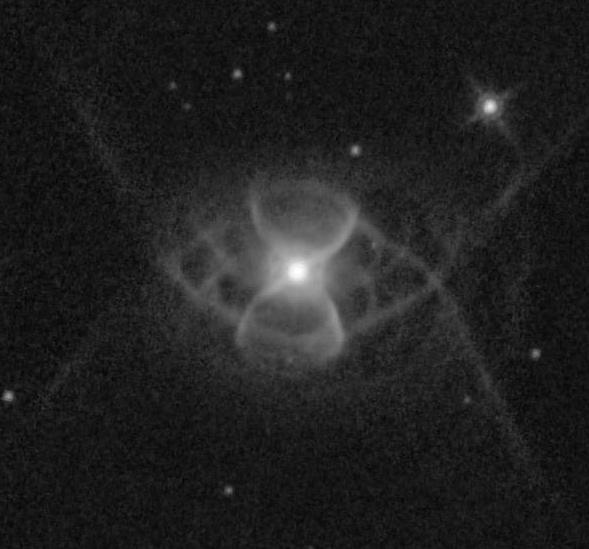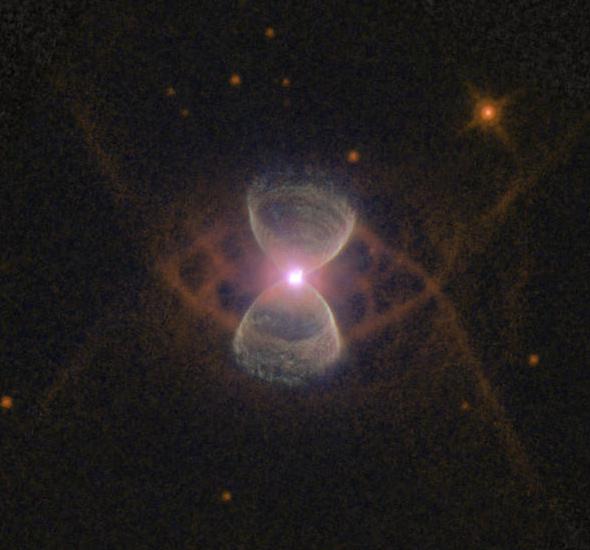When a star dies, it can be lovely.
When a star dies with another nearby, it can be amazing.
The image above shows Hubble 12 (also called HB 12 for short), what astronomers call a planetary nebula, the gas and dust thrown off by a star as it ends its life. When the star runs out of fuel in its core needed to generate the energy it uses to sustain itself, the outer layers of the star can be thrown off in a series of winds, like a solar wind on steroids.
This can form odd and intriguing shapes, including hourglass figures, elongated figures like two squids kissing, and even more bizarre objects.
But HB 12 has an extra ingredient or two. One of them is that the star in the center isn’t one star, but two. They orbit each other pretty close together, their orbital velocities high. This can help shape the wind blown out by the one star that’s dying; it adds a component of centrifugal force. Most of the material flung out goes out along the orbital plane of the two stars, forming a disk. Other stuff hits this disk and flows up and away, forming the hourglass figure.
Another ingredient is the fact that HB 12 sits in a region of the galaxy thick with interstellar gas and dust. Some observations indicate there’s quite a bit of it surrounding the stars, and the wind is plowing into that material, which confines it. That may be why the edges of the shapes you see in the image are so well defined. It also makes the nebula denser, and therefore brighter; HB 12 has one of the highest “surface brightnesses” of any nebula—that means any given piece of it is pretty bright compared with the same size section of another nebula.
But there’s a lot more going on here. If you look at the inner nebula, the part that looks like a butterfly, you can see brighter rings going around the cone-shaped “wings” (reminding me of the old Rocketdyne F-1 engines used on the Saturn V rocket). Each one of these may have been due to a gust of wind from the star, an episodic hiccup that temporarily increased the amount of material blown out. Given the spacing in the rings, they probably occur every 50 years or so. So twice a century the star went through some sort of event that increased its outflow. It’s not clear what that event might be.
Those outer structures, though! What a mess. But if you look carefully, you see symmetry. For every U-shaped structure you see, there’s an upside-down U to match it. That’s because every time the star blows out material, it does so in both directions, up and down. That might be more clear in a grayscale version of the image:

NASA/ESA/Judy Schmidt
The exact cause of all these structures has me scratching my head, though. The eye-shaped oval in particular is weird. I’d expect that to be an ellipse, a circle of expanding material seen at an angle (like looking at a water glass from an angle makes the circular opening appear like an ellipse). However, in this case it has sharper cusps on the left and right. That might simply be due to a weird perspective; the gas here is thin, and you can see through it, so you’re seeing the front and back side of the nebula on top of each other.
So that wide open structure on the outside is probably much like the inner, bright butterfly structure. Perhaps it’s just older and has had more time to spread out. If that’s the case, I see at least three such structures here, which hints that the dying star has had a lot of increased activity over the years.
And this I find particularly interesting: Just outside the central bright point marking the star’s position, you can see two parallel circular features, one just above and one just below the star. That reminds me very strongly of NGC 1514, another planetary nebula:

NASA/JPL-Caltech
As I wrote then, such features aren’t well-understood. What shapes them, why are they on opposite sides of the star like that, why are they so bright? It’s not clear.
Actually, there’s a lot that’s not well known about this object. We’re not even sure of its distance! Various methods to measure that yield wildly different results; everything from 7,500 light-years to more than 25,000 light-years! I suspect it’s probably on the closer end of that range, but who knows?
Here’s another interesting thing: This nebula is young. Measuring the speed of the expansion of the features and then tracing that back,* the age of the nebula is probably more than 1,000 years. That’s consistent with what we know about such objects; the gas is thrown out pretty quickly, and the planetary nebula stage of a dying star lasts millennia at most. The expanding gas becomes too thin and too distant for the star to light up, and the nebula fades.
I love planetary nebulae; I studied them both for my master’s degree and Ph.D. Very little was known about them before the advent of digital cameras, they’re pretty faint and small. But now we have extremely sensitive detectors and telescopes like Hubble, capable of imaging their fantastic structures.
And one last thing: The images you see here of HB 12 were processed and constructed by Judy Schmidt, who likes to reprocess data from the Hubble Space Telescope and create beautiful images. Her work has been featured here on the blog many times, and you can also see her creations on her website and on her Flickr page. Follow her on Twitter to get the latest updates, too. We had a fun conversation about this nebula, and I hope she tackles more such objects in the future.
*It’s a bit like knowing how far you’ve driven knowing your speed and how long you’ve been on the road. If you know the size of the nebula and how quickly it’s expanding, working the math backwards gives you the age.
